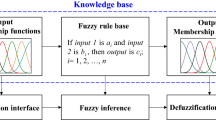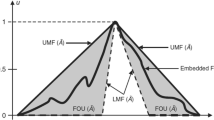Abstract
Among the control devices considered for dissipating seismic energy and reducing structural vibrations is the magnetorheological (MR) damper which consists of a hydraulic cylinder filled with a suspension of micron-sized, magnetically polarizable iron particles capable of reversibly changing from free-flowing, linear viscous fluid to semi-solid with the application of a magnetic field. Several algorithms have been proposed for regulating the amount of damping provided by MR dampers. An attractive option is the use of fuzzy controllers because they are simple, intrinsically robust, and they do not depend on a model of the system. Tuning of these controllers, however, has shown to be a difficult task because of the large number of parameters involved. This paper proposes a self-tuning fuzzy controller to regulate MR dampers’ properties and reduce structural responses of single degree-of-freedom seismically excited structures. Robustness to changes in seismic motions and structural characteristics was assessed by subjecting a rigid and a flexible building to different earthquake records. Results show that the self-tuning controller proposed effectively reduced responses of both structures to all earthquakes considered. In addition, results were compared to those of a fuzzy controller with constant scaling factors and to those of two passive strategies: “passive on” and “passive off”, where the current to the MR dampers was set to its maximum allowable value, and zero, respectively.
Similar content being viewed by others
Abbreviations
- CSM:
-
Continuous sliding mode
- LQG:
-
Linear-quadratic-Gaussian
- MR:
-
Magnetorheological
- RMS:
-
Root mean square
- SDOF:
-
Single degree-of-freedom
References
Arslan A, Kaya M (2001) Determination of fuzzy logic membership functions using genetic algorithms. Fuzzy Sets Syst 118: 297–306
Chang C-C, Zhou L (2002) Neural network emulation of inverse dynamics for a magnetorheological damper. J Struc Eng 128(2): 231–239
Chao CT, Teng C-C (1997) A PD-like self-tuning fuzzy controller without steady-state error. Fuzzy Sets Syst 87: 141–154
Choi K-M, Cho S-W, Jung H-J, Lee I-W (2004) Semi-active fuzzy control for seismic response reduction using magnetorheological dampers. Earthq Eng Struc Dyn 33: 723–736
Dalei G, Jianqiang Y (2002) Semi-active seismic isolation control based on MR damper and neural networks. In: Proceedings of the 6th international conference on motion and vibration control, Saitama, Japan
Daugherity WC, Rathakrishnan B, Yen J (1992) Performance evaluation of a self-tuning fuzzy controller. In: Proceedings of IEEE international conference on fuzzy systems, San Diego
Driankov D, Hellendoorn H, Reinfrank M (1993) An introduction to fuzzy control. Heidelberg: Springer, Berlin
Dyke SJ (1998) Seismic protection of a benchmark building using magnetorheological dampers. In: Proceedings of the 2nd world conference on structural control, Japan
Dyke SJ, Spencer BF Jr (1997) Comparison of semi-active control strategies for the MR damper. In: Proceedings of the international conference on intelligent information systems, Bahamas
Dyke SJ, Spencer BF Jr, Sain MK, Carlson JD (1996a) Experimental verification of semi-active structural control strategies using acceleration feedback. In: Proceedings of the 3rd international conference on motion and vibration control, Chiba, Japan
Dyke SJ, Spencer BF Jr, Sain MK, Carlson JD (1996b) Modeling and control of magnetorheological dampers for seismic response reduction. Smart Mater Struc 5: 565–575
Faravelli L, Yao T (1996) Use of adaptive networks in fuzzy control of civil structures. Microcomput Civil Eng 11: 67–76
Hiemenz GJ, Choi Y-T, Wereley NM (2000) Seismic control of civil structures utilizing semi-active MR bracing systems. In: Proceedings of smart systems for bridges, structures, and highways conference, Newport Beach
Jang J-SR, Gulley N (1994) Gain scheduling based on fuzzy controlled design. In: Proceedings of NAFIPS-IFIS-NASA, San Antonio
Jansen LM, Dyke SJ (2000) Semi-active control strategies for MR dampers: a comparative study. J Eng Mech 126(8): 795–803
Li H-X, Gatland HB (1996) Conventional fuzzy control and its enhancement. IEEE Trans Syst, Man, Cybern 26(5): 791–797
Liu Y, Gordaninejad F, Evrensel CA, Hitchcock G (2001) An experimental study on fuzzy logic vibration control of a bridge using fail-safe magneto-rheological fluid dampers. In: Proceedings of smart systems for bridges, structures, and highways conference, Newport Beach
MacVicar-Whelan PJ (1976) Fuzzy sets for man-machine interactions. Int J Man-Mach Stud 8: 687–697
Maeda M, Sato T, Murakami S (1990) Design of the self-tuning fuzzy controller. In: Proceedings of the international conference on fuzzy logic and neural networks, Iizuka
Marazzi F, Magonette G (2001) Active and semi-active control of structures: a comparison. In: Proceedings of the European meeting on intelligent structures, Ishia
McClamroch NH, Gavin HP (1995) Closed loop structural control using electrorheological dampers. In: Proceedings of the American control conference, Seattle
Ni YQ, Chen Y, Ko JM, Cao DQ (2002) Neuro-control of cable vibration using semi-active magneto- rheological dampers. Eng Struc 24: 295–307
Nishimori K, Hirakawa S, Hiraga H, Ishihara N (1994) Selection of fuzzy control rules using automatic tuning of membership functions. In: Proceedings of NAFIPS-IFIS-NASA, San Antonio
Sadek F, Mohraz B (1998) Semiactive control algorithms for structures with variable dampers. J Eng Mech 124(9): 981–990
Schurter KC, Roschke PN (2001a) Neuro-fuzzy control of structures using acceleration feedback. Smart Mater Struc 10(4): 770–779
Schurter KC, Roschke PN (2001b) Neuro-fuzzy control of structures using magnetorheological dampers In: Proceedings of the American control conference, Arlington
Shiraishi T, Nakaya N, Morishita S (2002) Structural control by a variable damper using MR fluid. In: Proceedings 6th international conference on motion and vibration control, Saitama, Japan
Spencer BF Jr, Dyke SJ, Sain MK, Carlson JD (1997) Phenomenological model of a magnetorheological damper. J Eng Mech 123(3): 230–238
Sreenatha AG, Pradhan M (2002) Fuzzy logic controller for position control of flexible structures. Acta Astronaut 50(11): 665–671
Wilson CMD (2005) Fuzzy control of magnetorheological dampers for vibration reduction in civil structure. Dissertation, Florida State University
Wilson CMD, Abdullah MM (2005a) Fuzzy control of magnetorheological dampers in civil structures. In: Proceedings of 6th European conference on structural dynamics, Paris
Wilson CMD, Abdullah MM (2005b) Structural vibration reduction using fuzzy control of magnetorheological dampers. In: Proceedings of the ASCE structures congress, New York
Wong F, Chou K, Yao J (1999) Civil engineering including earthquake engineering. In: Zimmermann H-J (eds) Practical applications of fuzzy logic. Kluwer, Boston, pp 207–245
Woo Z-W, Chung H-Y, Lin J-J (2000) A PID type fuzzy controller with self-tuning scaling factors. Fuzzy Sets Syst 115: 321–326
Xu YL, Qu WL, Ko JM (2000) Seismic response control of frame structures using magnetorheological/ electrorheological dampers. Earthq Eng Struc Dyn 29: 557–575
Xu Z-D, Shen Y-P, Guo Y-Q (2003) Semi-active control of structures incorporated with magnetorheological dampers using neural-networks. Smart Mater Struc 12: 80–87
Yager RR, Filev DP (1994) Essentials of fuzzy modeling and control. Wiley, New York
Yang G (2001) Large-scale magnetorheological fluid damper for vibration mitigation: modeling, testing and control. Dissertation, University of Notre Dame
Yang G, Spencer BF Jr, Carlson JD, Sain MK (2002) Large-scale MR fluid dampers: modeling, and dynamic performance considerations. Eng Struc 24(3): 309–323
Yeh K, Chiang W-L, Juang D-S (1994) Application of fuzzy control theory in active control of structures. In: Proceedings of NAFIPS-IFIS-NASA, San Antonio
Yi F, Dyke SJ, Caicedo JM, Carlson JD (2001) Experimental verification of multi-input seismic control strategies for smart dampers. J Eng Mech 127(11): 1152–1164
Yoshida O, Dyke SJ, Giacosa LM, Truman KZ (2002) Torsional response control of asymmetric buildings using smart dampers. In: Proceedings of the 15th ASCE engineering mechanics conference, New York
Zhang J, Roschke PN (1999) Active control of a tall structure excited by wind. J Wind Eng Ind Aerodyn 83: 209–223
Zhao Y (2001) Autotuning of an industrial weigh belt feeder. Dissertation, Florida State University
Zhao Y, Collins EG Jr, Dunlap D (2003) Genetic fuzzy parallel parking control for autonomous ground vehicles. In: Proceedings of the American control conference, Denver
Zheng LA (1992) A practical guide to tune of proportional and integral (PI) like fuzzy controllers. In: Proceedings of the 1st IEEE international conference on fuzzy systems, San Diego
Zhou L, Chang C-C (2000) Adaptive fuzzy control for a structure-MR damper system. In: Proceedings of the smart systems for bridges, structures, and highways conference, Newport Beach
Zhou L, Chang C-C, Spencer BF Jr (2002) Intelligent technology-based control of motion and vibration using MR dampers. Earthq Eng Eng Vib 1(1): 100–110
Author information
Authors and Affiliations
Corresponding author
Rights and permissions
About this article
Cite this article
Wilson, C.M.D., Abdullah, M.M. Structural vibration reduction using self-tuning fuzzy control of magnetorheological dampers. Bull Earthquake Eng 8, 1037–1054 (2010). https://doi.org/10.1007/s10518-010-9177-7
Received:
Accepted:
Published:
Issue Date:
DOI: https://doi.org/10.1007/s10518-010-9177-7




